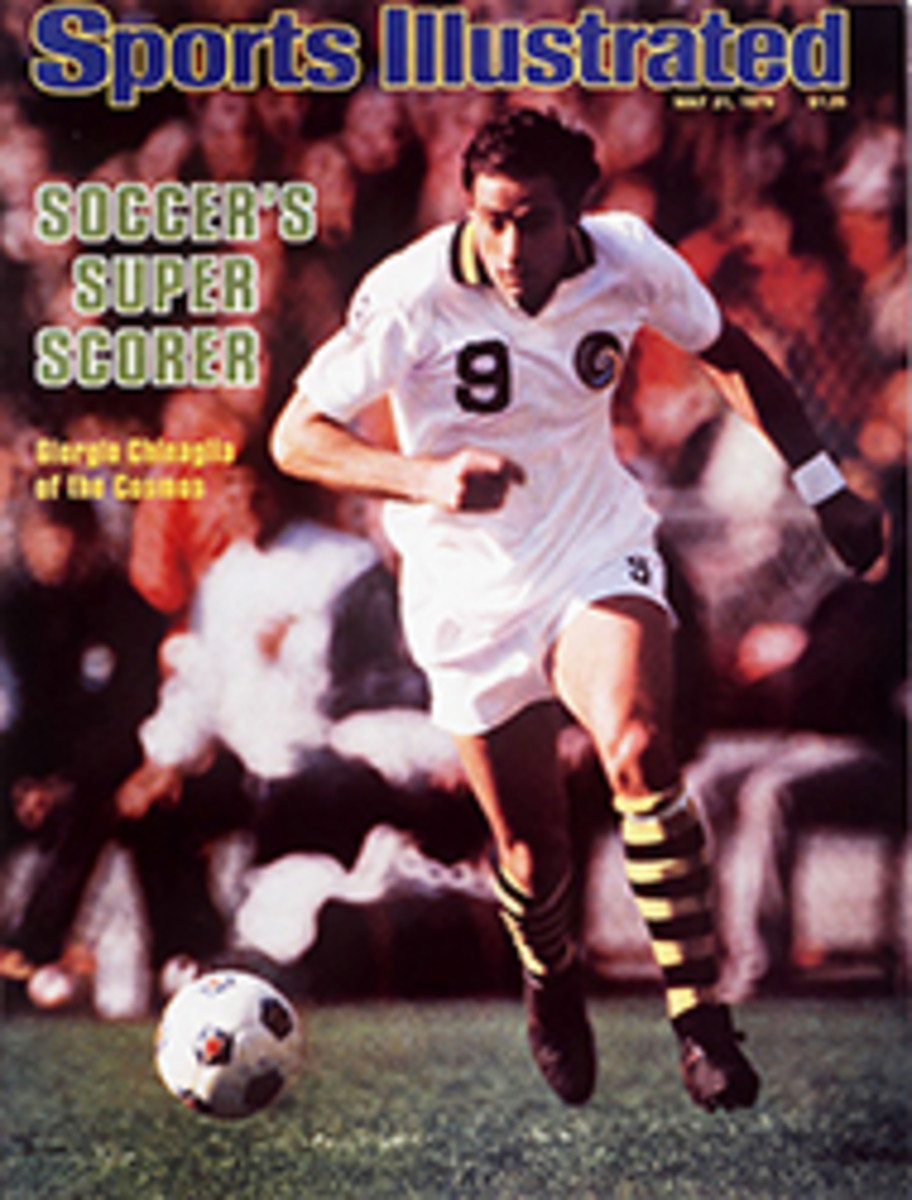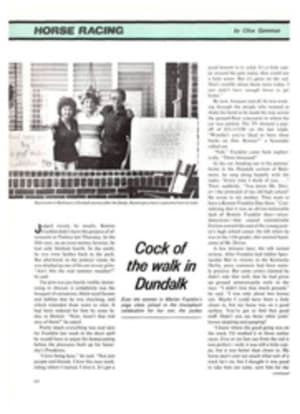
NEWARK WASN'T THE BEST BALL CLUB IN '37. WOULD YOU BELIEVE SECOND?
In 1937 there was no argument that the New York Yankees were the best team in baseball. They won 102 games, they coasted to their second straight American League pennant by 13 games and crushed the Giants in five games in the World Series. But what was the second-best team that year? According to many, it wasn't the Giants, nor was it the American League runner-up, the Detroit Tigers. It was the Newark Bears, a Yankees' Double-A franchise (in those days there was no such thing as Triple-A), a juggernaut that took the International League like F.D.R. took Landon.
The Bears won 109 regular-season games in 1937, plus 12 postseason games on the way to winning the Little World Series. The club led the International League by an incredible 25½ games. The top four pitchers had a combined record of 73-16. The team batting average was .299. They were shut out only once in 167 games. Seven of the 10 regulars hit .300 or better (another hit .298), and the top five hitters were first, second, fourth, fifth and eighth among league regulars. Only five players in the league scored 100 or more runs that season and four of them played for the Bears. The team averaged almost six runs per game and had a winning percentage in its home ball park of .789; overall, the record was .717. Only one player on the roster failed to make it to the major leagues.
The Bears of 1937 produced a brilliant flash before the minor leagues' lamp began to dim. The '40s and '50s brought television, and major league games could be seen where only minor league ball had been available. Expansion robbed the minors of most of their prime market areas and gobbled up talent that previously might have stayed on the farm a little longer. Attendance fell off, support from the major leagues dwindled, teams went out of business, leagues died. Today the minor leagues consist of only four divisions—Rookie leagues, Class A, Double-A and Triple-A—and college baseball has cut into them.
But in the late 1930s, the minors prospered. Following the St. Louis Cardinals' lead in developing a farm system, the Yankees soon created a chain of powerhouses from Double-A down to Class D. In the spring, Yankee training camps bulged with young talent that competed not only to fill spots on the parent club, but to make the Newark roster rather than Kansas City, Kansas City rather than Binghamton, Binghamton rather than Norfolk. Newark was especially desirable because it was right across the Hudson from New York, thus offering the players opportunities to impress the Yankee brass. Newark was where Ed Barrow, the Yankees' general manager, put his likeliest prospects.
A couple of hot ones topped the Bears' roster during the spring of '37. Rightfielder Charlie Keller, a 20-year-old from the University of Maryland, was slamming the ball around hard enough to be called "the next Babe Ruth." And Joe Gordon, an impressive-looking infielder from Oregon, was being groomed by Newark Manager Oscar Vitt as the eventual replacement for aging Yankee Second Baseman Tony Lazzeri.
The Bears got off to only a so-so start. By May 11, they were 9-6. Then the team began to move. A month later Newark was 35-11, and by July 1, with a 53-15 record, the Bears had a 16½-game league lead. With such a runaway, one might have thought that attendance would drop around the league, that the folks in Jersey City, Buffalo, Syracuse, Toronto, Baltimore, Montreal and Rochester would turn their attention to more pressing matters of the time: the search for Amelia Earhart in the Pacific, the marriage of the Duke and Duchess of Windsor, the progress of the Dionne quintuplets, the budding courtship of Abner Yokum and Daisy Mae. But, to the contrary, attendance reached record levels.
In Newark, fan interest was particularly intense. Farm Director George Weiss could always get a rise out of Barrow by reporting attendance figures superior to those of the Yankees, but that year both knew they were watching greatness. Newark was a city of factories, with neighborhoods populated by blue-collar workers who loved their city and their team. They worked hard, and old Ruppert Stadium, a charmless fortress of concrete and steel, was a place where they could buy a cheap seat, sit in the stands with their friends and watch the athletes pass through on their way to the cherished Yankee pinstripes.
Not many Newarkers had the money to venture to a Yankee game. Once the Kellers and Gordons and Spud Chandlers and Tommy Henrichs made the big leagues, they became just names in a newspaper box score. But as long as they wore the hometown N, the fans could love them as their own.
When the 1937 regular season finally ended, the Bears were 25½ games ahead of Montreal, with a 109-43 record. Keller had hit .353 in his first year of organized ball. Babe Dahlgren, the third baseman, hit .340. The two catchers, Buddy Rosar and Willard Hershberger, hit .332 and .325, respectively. First Baseman George McQuinn hit .330. Gordon hit only .280, but he had 26 home runs. The two outfielders besides Keller—Bob Seeds and Jim Gleeson—hit .305 and .298. Utility Infielder Frankie Kelleher hit .306. Big Joe Beggs led the pitchers with a 21-4 record. Fastball artist Atley Donald was 19-2, Vito Tamulis, the little lefty, 18-6, and another hard thrower, Steve Sundra, was 15-4.
In the playoffs the first- and third-place teams in the league and the second- and fourth-place teams squared off, then the winners met and the survivor of that battle was matched against the American Association champion in the Little World Series.
As expected, the Bears swept a good Syracuse team in the semis and took four straight from hard-hitting Baltimore. The first real drama of the season for Newark came when it faced Columbus, one of the St. Louis Cardinals' two Double-A representatives, in the Little World Series. The Red Birds featured Enos Slaughter, who hit .382 that year, with 26 home runs and 122 RBIs. Columbus also had a quartet of excellent pitchers in Bill McGee, Mort Cooper, Max Lanier and 21-game winner Max Macon, whom many baseball people were calling the next Dizzy Dean.
The Series, which began in late September, was publicized as a classic confrontation between the two best farm systems in baseball. Yankee pride was at stake, and Colonel Jacob Ruppert, the president, told Weiss that he wanted and expected another sweep. But in the first three Series games, all played in Newark, the Red Birds shocked the Bears 5-4, 5-4 and 6-3. Not only had the Bears' hitting and pitching failed them, but they had committed 11 errors in the three games. What had happened to the Wonder Team?
The opponents then went to Columbus for the rest of the Series. "We had a team meeting on the train," Atley Donald recalls, "and simply reassured each other that we were the same ball club we'd been all year. Win or lose, we decided to be free and easy and let the chips fall where they may."
In the Columbus opener, the Bears turned the tables on the home team, winning 8-1. The fifth game of the Series was a pitching thriller between Donald and Macon. The Bears nursed an early 1-0 lead inning after inning. The pressure was heavy, Donald remembers, but the big righthander held Columbus to three hits and no runs, and Newark won 1-0. In Game 6, the Bears evened the Series, crushing four Columbus pitchers 10-1. In the decisive seventh game the Bears, striking for three runs in both the fifth and sixth innings, came out on top 10-4.
The team received a grand homecoming at Penn Station in Newark, followed by a parade up Broad Street. Colonel Ruppert brought them to New York, where they were feted and given special seats for the World Series then in progress. Yankee Stadium was, of course, where every Bear hoped eventually to be. For most of the players, Newark was just another stopover on their way to the majors. Hy Goldberg of the Newark Evening News lamented in his final baseball column of the 1937 season: "There is one sad feature about a great minor league ball club. It's always broken up, and the better the team the sooner the dissolution. The major leagues are calling and the Bears of 1937, as a unit, have trod the diamond for the last time."
It was the end of the Wonder Team. Keller returned to Newark in 1938, hitting .365 and leading the Bears to another International League championship, but most of the others were gone. Gordon starred at second base for the Yankees, and later the Cleveland Indians, and was named the American League's Most Valuable Player in 1942. Donald became a key member of the Yankees' staff through 1945, setting a team record of 12 straight wins in 1939. Following his retirement he became a scout and signed Ron Guidry, the man who broke Donald's record.
Keller joined the Yankees in 1939 and was one of their big hitters until he entered the Merchant Marine in 1944. Beggs was a star relief pitcher for the 1940 world champion Cincinnati Reds. McQuinn became a solid hitter for the St. Louis Browns for several seasons, and Rosar, Tamulis and Sundra all played in the majors with some success. Weiss eventually used Newark as a springboard to become general manager of the parent Yankees.
But not all of the members of the Wonder Team lived up to their promise. Vitt became boss of the Cleveland Indians in 1938, but his jittery dugout behavior eventually got him embroiled in the bizarre Cleveland "Cry Baby Rebellion" of 1940. He was fired following the season, an embarrassed and disgraced man, and never managed in the majors again. Dahlgren, a hitter of considerable promise, had the misfortune to be Lou Gehrig's replacement in 1939. Under that pressure he never approached his potential and is now just an answer to a baseball trivia question.
Bob (Suitcase) Seeds, who had tried and failed in the majors before 1937, tried and failed again. Seeds did have one magical moment in 1938, an amazing two days in which he had nine hits in 10 at bats—including seven home runs—and drove in 17 runs. But that was back in the International League while playing for Buffalo. Like Steve Bilko, Rocky Nelson, Lou Novikoff, Ox Eckhardt, Jigger Statz and countless others, he was one of those hitters who for some reason could never hit in the majors despite brilliance down on the farm. The most haunting and tragic fate, however, awaited Willard Hershberger, a moody, troubled sort of man who went on to become the backup catcher for the Cincinnati Reds. Donald remembers him as a worrier and a loner.
In 1940, in the midst of a pennant race, Hershberger locked himself in a hotel room in Boston and cut his throat with a razor. Manager Bill McKechnie said the catcher had been brooding about his hitting.
By the late 1940s Newark couldn't compete in the same television market as the Yankees, Giants and Dodgers (to say nothing of Uncle Miltie and Gorgeous George), and in 1949 the Bears were put to rest. Ruppert Stadium was turned over to a high-school team.
But when those who remember the Bears get together and talk about the old days on Wilson Avenue in the Ironbound section, someone is bound to say, "Do you know, I was there one day and saw Joe Gordon make a play I still don't believe. Jersey City had men on first and third, and...."
PHOTO ILLUSTRATION

